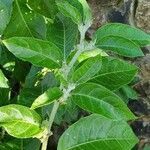Erect shrub to 1 m. All parts grey-pubescent with dendritic hairs. Leaves ovate, the lamina up to 8 cm long, and 4.5 cm wide, usually c. 5 cm long, 3 cm wide; petiole c. 1 cm long. Inflorescence a congested cluster of 4–6 flowers; pedicels 3–5 mm long. Calyx 4–6 mm long at time of flowering; lobes shortly triangular with linear apices, 2–3 mm long. Corolla 5–6 mm long, dull yellow-green; lobes triangular, 1.5–3 mm long, spreading. Anthers 1 mm long. Ovary obtusely conical, 1–1.5 mm long; style 3 mm long. Berry globular, 5–10 mm diam., shining red, surrounded by urn-shaped inflated calyx, the tube 15–20 mm long. Seeds more or less disc-shaped, 1.5–2.2 mm long, light brown.
Erect, perennial shrub, up to 1 m high; vegetative parts with whitish branched hairs. Stems ± striate, ± brown, densely and shortly pubescent. Leaves ovate-oblong to elliptic, up to 80 x 35 mm, margins entire to ± wavy, narrowed into ± 20 mm long petioles, glabrescent. Flowers in small, axillary clusters; pedicels 5 mm long. Calyx densely pubescent. Corolla campanulate, 7 mm long, yellow or yellow-green. Fruit globose berries, ± 8 mm in diam., bright red, inside 20 mm long enlarged membranous calyces. Seeds kidney-shaped, 2.5 mm in diam., reticulated, very pale brown. Flowering time all year, mainly Nov.
Leaves alternate or distally ± opposite; petiole 0.3–3.2 cm long, rather sheathing at the base; lamina membranous to somewhat fleshy, 2.5–17.5 × 1–7 cm, ovate to obovate, occasionally lanceolate or oblanceolate, rarely rotund, base obtuse to attenuate, occasionally rounded or truncate, and often oblique or occasionally unequal-sided, ± decurrent into the petiole, apex obtuse to acute, sometimes acuminate, entire to sinuate, whitish tomentose, becoming sparsely pubescent above and more densely so beneath especially on the nerves.
A small erect shrub. It grows 1.5 m high. It is woody in the lowest parts. The stems have few branches. The leaves are oval or oblong and have a wedge-shaped base. They have a short stalk and do not have teeth. The leaves are covered in star-shaped hairs. The flowers are greenish or yellow and are 5 mm across. They are bell shaped. They are usually in clusters of 4-6 on side shoots. The fruit is a shiny red berry 5-8 mm across. The seeds are pear or kidney shaped.
Shrub, up to 1.5 m high. Stems terete, tomentose. Leaves shortly petiolate; blade ovate, obovate or oblong, margins entire or very slightly sinuate; petioles ± 10 mm long. Flowers: 4-6 in axillary fascicles; calyx with outer surface densely tomentose, enlarging and completely enclosing berry; corolla ± 5.5 mm long, divided nearly to middle into 5 triangular lobes, yellow or yellowish green; Oct.-Jul. Fruit a globose berry, 6-7 mm long, glabrous.
Calyx 3–5.5(7) mm long, 2–3.5(4) mm across, often slightly 5-or 10-ribbed, divided to c. the middle into 5 triangular to lanceolate or sub-linear lobes 1.4–3 × 0.8–1.6 mm, tomentellous outside and on the lobes inside; in fruit papyraceous or scarious, brownish, (10)12–24 × (8)9–17 mm, urceolate or ovoid-conic, ± 5-angled and somewhat 10-ribbed, sunken at the base, ± acute, acuminate at the summit, the lobes 2–5 × 1–3 mm, somewhat glabrescent.
Corolla yellowish to greenish-white or greenish, 4–7(8) mm long, campanulate or tubular-infundibular, divided to near the middle or less, hairy with finger-like hairs on the upper part of the tube and lobes outside, also with a band of longer hairs inside above insertion of the filaments; limb 3–6.5(7) mm across; lobes 5, 1.5–3(4) × 1.3–2.5 mm, triangular or triangular-lanceolate, acute, sub-acute or sometimes acuminate.
Shrub, up to 1.5 m high. Leaves ovate, obovate or oblong, entire or very slightly sinuate, shortly petiolate, 30-150 x 10-70 mm. Flowers 10-15 cm axillary fascicles. Calyx densely tomentose outside, enlarging and completely enclosing berry. Flowers yellow or yellowish green.
Erect, sometimes spreading or more rarely decumbent, often bushy, herb or shrub, with usually several–many stems arising from a woody rootstock; younger parts whitish or greyish tomentose with small branched hairs, glabrescent.
Stamens 5, scarcely exserted, glabrous; filaments 2.5–3(3.5) mm long; anthers 0.6–1 mm long, ovate-oblong in outline, the connective often apiculate.
Fruit green turning brick-coloured, orange or red when ripe, glossy, subsessile in the erect to pendulous calyx, (5)6–10(12) mm in diameter.
Seeds 2–2.5 × 1.5–1.8(2.5) mm, lenticular-reniform, sometimes ovate or elliptic in outline, orange, bright red or pale brown.
Flowers (1)2–8(10) at a node, erect to nodding; pedicels (1)2–4(5) mm long, slender, in fruit elongated to 9 (or more) mm.
Ovary 1–2(2.5) × 0.7–1.5(2) mm, ovoid, glabrous; style 2–3.5 mm long, scarcely exserted.
Branches terete or somewhat angular, striate.
Much-branched undershrub 3-7 ft. high
Disk 0.2–0.4 mm high.
Flowers small, pale.













